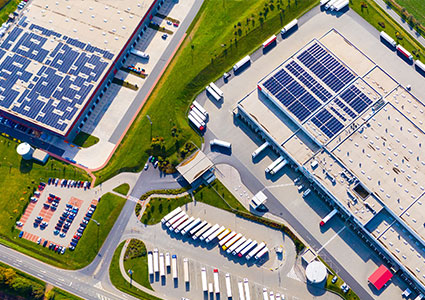Roofing and insulation considerations for rapidly growing commercial facilities
As construction starts continue to rise for data centers and cold storage facilities, along with multi-family housing starts projected to increase in 2025, construction professionals must leverage tailored roofing and insulation solutions to enhance energy efficiency, durability, and long-term cost savings.
Economic and technological trends are driving rapid growth in three key sectors of new construction. The construction of data centers is increasing to meet growing digital demands, even as office space construction stagnates. Cold storage facilities are also in high demand, spurred by the rise in online grocery delivery and the need for secure medical storage. Meanwhile, multi-family housing units will likely become more popular as interest rates remain high for prospective homeowners. 
Each of these sectors presents distinct challenges when designing roofing systems, particularly when it comes to balancing local building code requirements, construction budgets, durability, and long-term cost savings. For construction professionals, choosing the right roofing and insulation materials is a key component of optimizing the use of these high-demand facilities.
Data centers
The high demand for data storage presents a lucrative opportunity for builders of data centers. In this fast-paced sector, speed of installation is critical to keep up with development timelines. Properly designed and insulated roofing systems must be installed quickly while delivering superior quality and reliable performance.
Self-adhered TPO systems streamline the installation process and can be installed up to four times faster than conventionally adhered systems. Third-party testing* has shown that Elevate™ UltraPly TPO™ SA reduces labor hours by up to 77 percent per ‘square’ (equal to 100 square feet in roofing terms) for the membrane installation, helping contractors meet the growing demand and keep up with the pressure to complete jobs quickly.
Cold storage facilities

Cold storage facilities are a specialized segment within the commercial construction sector, driven by the growing demand for refrigerated storage to support food delivery services and pharmaceutical needs. The unique challenge these buildings face stems from the need for precise temperature control, with internal temperatures often ranging from -50 to 40 degrees Fahrenheit.
Thus, the top consideration for cold storage facility construction is the need for high-performance roofing insulation. Polyiso roofing insulation, known for its high thermal resistance capabilities, offers an R-value of approximately 5.7 per inch at a mean temperature of 75 degrees Fahrenheit, which is ideal for climate-controlled buildings like data centers. This makes polyiso a top choice, where temperature regulation is key to maintaining the functionality of the equipment inside. Elevate ISOGARD™ polyiso insulation performed up to 40 percent better than major competitors when tested by an independent third party at 40 degrees Fahrenheit according to ASTM C1289 standards**. This means its performance improves the colder it gets.
Because these facilities often experience extreme temperature differences between the interior and exterior, limiting the movement and accumulation of water vapor poses challenges for designers. Vapor molecules naturally migrate from warmer to cooler areas, and in cold storage, this can lead to condensation, buildup of moisture inside the building, and damage to the roof or the building structure. Design professionals may specify the use of an air or vapor retarder, such as V-ForceTM Vapor Barrier Membrane, to minimize air and water vapor from infiltrating the roofing system. Effective vapor drive prevention bolsters the building’s energy efficiency and helps ensure a long-lasting roofing system.
Multi-family housing units
The projected growth of multi-family housing is driven by several factors: rising interest rates, the high cost of homeownership, and a limited supply of single-family homes. Developers will increasingly turn to multi-family housing projects to meet market demand.
Well-insulated roofing systems play an important role in reducing energy consumption and lowering utility costs for tenants. Regional climate is one of the top factors in determining the best roofing options. For example, in southern climates, reflective roofs help minimize heat gain and reduce the strain on cooling systems during the summer. In northern climates, heat-absorbing roofs can reduce the demand on heating systems during colder months.
For re-roofing an existing multi-family housing unit, Elevate APP and SBS-modified bitumen roofing systems are time-proven and the choice of many building owners and contractors for completing projects quickly and on budget. Elevate modified bitumen systems perform well in all climates and are made to last. A self-adhered system, whether TPO or EPDM, is also ideal for re-roofing as the VOC-free formulation allows contractors to install a new roofing membrane while tenants remain in the building with minimal disruptions.
Conclusion
As the construction of multi-family housing, data centers, and cold storage facilities expands, it’s important for builders to keep up with the latest, high-performing roofing and insulation technologies and install the customized roofing system best suited to meet the specific needs of each job. This includes the energy efficiency requirements of multi-family housing to the rapid installation needs of data centers, and the extreme temperature controls required in cold storage facilities.
For a list of the sources used in this article, please contact the editor.
By Jamie Gentoso
holcimelevate.com/us-en/find-contractor
Jamie Gentoso is President of Holcim Building Envelope and Global Head of Holcim Solutions & Products. Holcim Building Envelope delivers high-performance solutions for the entire building envelope, including commercial and residential roofing, wall, and lining systems. As part of Holcim Building Envelope’s powerful portfolio, Elevate Commercial Roofing Systems brings over 40 years of expertise in advanced and sustainable roofing solutions, reflecting Holcim’s commitment to quality, innovation, and industry leadership.
*Based on testing conducted by a third party in 2017 using UltraPly™ TPO SA versus standard adhered TPO. Application times vary with settings and environmental factors; actual results will vary.
**ISOGARD polyiso insulation performed up to 40 percent better in cold temperature 40°F (4°C) applications according to ASTM C1289 standards than major competitors when tested by an independent third party in September 2022. The increased R-value per inch indicates better thermal performance in cold temperature 40°F (4°C) from the same roofing systems using the same amount of insulation compared to leading competitive products on the market today. Results may vary.
